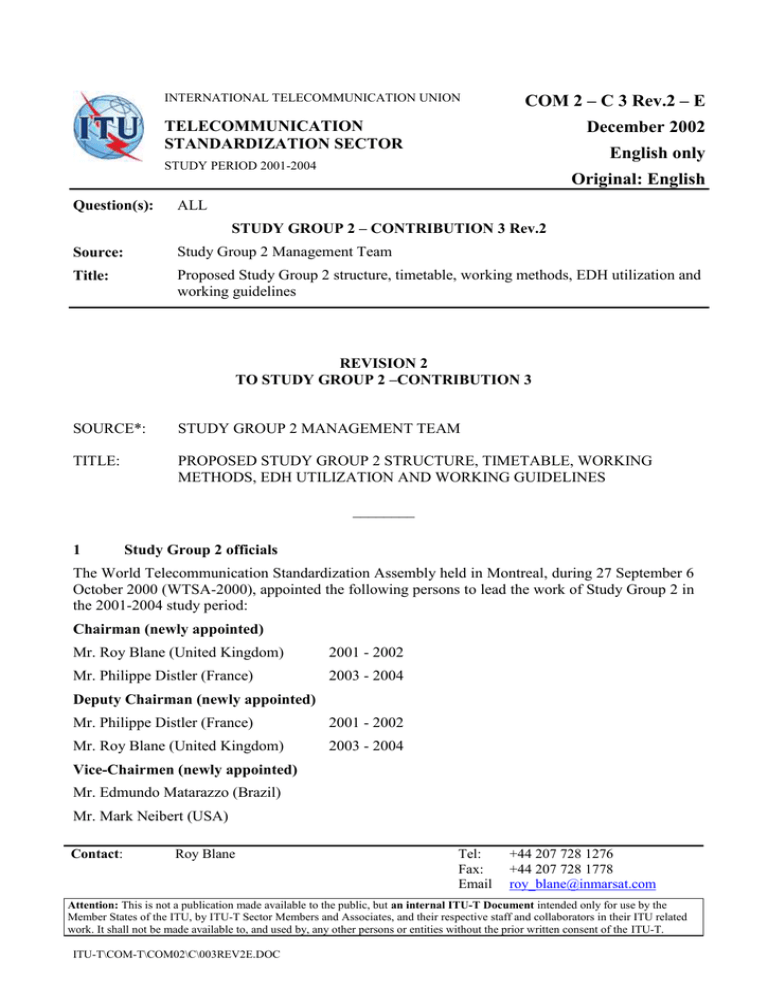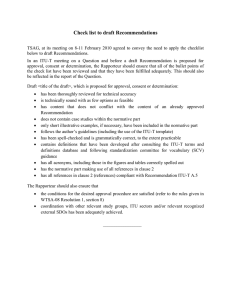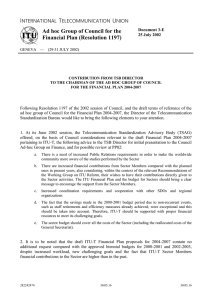COM 2 – C 3 Rev.2 – E December 2002 English only
advertisement

INTERNATIONAL TELECOMMUNICATION UNION COM 2 – C 3 Rev.2 – E TELECOMMUNICATION STANDARDIZATION SECTOR December 2002 English only STUDY PERIOD 2001-2004 Original: English Question(s): ALL STUDY GROUP 2 – CONTRIBUTION 3 Rev.2 Source: Study Group 2 Management Team Title: Proposed Study Group 2 structure, timetable, working methods, EDH utilization and working guidelines REVISION 2 TO STUDY GROUP 2 –CONTRIBUTION 3 SOURCE*: STUDY GROUP 2 MANAGEMENT TEAM TITLE: PROPOSED STUDY GROUP 2 STRUCTURE, TIMETABLE, WORKING METHODS, EDH UTILIZATION AND WORKING GUIDELINES ________ 1 Study Group 2 officials The World Telecommunication Standardization Assembly held in Montreal, during 27 September 6 October 2000 (WTSA-2000), appointed the following persons to lead the work of Study Group 2 in the 2001-2004 study period: Chairman (newly appointed) Mr. Roy Blane (United Kingdom) 2001 - 2002 Mr. Philippe Distler (France) 2003 - 2004 Deputy Chairman (newly appointed) Mr. Philippe Distler (France) 2001 - 2002 Mr. Roy Blane (United Kingdom) 2003 - 2004 Vice-Chairmen (newly appointed) Mr. Edmundo Matarazzo (Brazil) Mr. Mark Neibert (USA) Contact: Roy Blane Tel: Fax: Email +44 207 728 1276 +44 207 728 1778 roy_blane@inmarsat.com Attention: This is not a publication made available to the public, but an internal ITU-T Document intended only for use by the Member States of the ITU, by ITU-T Sector Members and Associates, and their respective staff and collaborators in their ITU related work. It shall not be made available to, and used by, any other persons or entities without the prior written consent of the ITU-T. ITU-T\COM-T\COM02\C\003REV2E.DOC -2COM 2 – C 3 Rev.2 – E 2 Study Group 2 Questions for 2001-2004 2.1 Please refer to contribution COM 2-1, which contains the texts of the Questions allocated to Study Group 2 by WTSA-2000. 2.2 To facilitate comprehension of contribution COM 2-1, please refer to Annex 1 for the number and title of the Study Group 2 Questions and their relationship to the Questions in the 19972000 study period. 3. Proposed Study Group 2 structure A draft proposed Study Group 2 structure, has been suggested by the Study Group 2 Management Team, for consideration by the Study Group at its first meeting in Geneva, 23 January - 2 February 2001 (please refer to Annex 2). 4 Mandates, rules, working methods 4.1 Your attention is drawn to TSB Circular 1, which contains the numbers and titles of the Resolutions and A-series Recommendations which were agreed at WTSA-2000 as well as information regarding electronic document submission and access to related Study Group documentation . The full texts of these Resolutions and recommendations can be obtained from the ITU website http://www.itu.int/ITU-T . 4.2 You are encouraged to procure a copy of this important TSB Circular from your within your organization or from the ITU website and keep it in your possession as a reference document during this study period. In particular, you are strongly encouraged to assist in promoting the efficiency of the work of the ITU-T by submitting contributions to Study Group 2 in electronic format. Appendix II to Recommendation A.2 consists of a guide on electronic submission of documents, which you are requested to follow. 5. Working Guidelines in Study Group 2 5.1 Documents will generally only be presented and discussed once in meetings of a specific question, to enable all contributions to be reviewed. 5.2 Rapporteurs and Associate Rapporteurs leading the discussions will ensure that the conclusion on each contribution is clearly stated in the meeting and recorded in the meeting report. To this end the source of each contribution should be invited to submit their summary of the conclusions reached by the meeting, to aid the work of the Rapporteur. 5.3 With respect to contentious issues, where unanimous agreement cannot be reached within the time allotted to the topic, the following approach will be adopted in an effort to progress the work: 5.3.1 If time is available in a subsequent session on the same topic, an ad-hoc group will be established to address and resolve the problem areas, and report back to the main group. The terms of reference of this ad-hoc group will be determined and agreed by the meeting which decides upon this course of action. 5.3.2 For relatively new topics, areas of agreement and outstanding issues will be summarised and recorded. Further contributions on the outstanding issues will be requested for future meetings and where possible an indication of the timeframes for completing these items should be provided to the meeting. ITU-T\COM-T\COM02\C\003REV2E.DOC -3COM 2 – C 3 Rev.2 – E 5.3.3 For older unresolved issues, the majority view will be adopted as the way forward in order to progress the work, but the fact that not all delegates were in agreement, will be recorded in the meeting report. 5.4 The atmosphere created at a meeting is viewed by the Study Group Management Team as being critical to both the short and long term success in concluding the studies which have been assigned by WTSA-2000. To this end all meetings should be conducted in a courteous and amicable manner irrespective of the commercial and competitive nature of the issues involved. Delegates are therefore encouraged to strive to maintain a good-humoured approach to issues which may prove to be contentious. 5.5 Closing Working Party Plenary sessions will utilise the Study Group 2 “Road Map” to assist participants in locating the appropriate documents being reviewed and agreed. It will be the responsibility of the respective Working Party Chairmen to ensure that this document is available for their final session. A copy of the “Road Map” is contained in Annex 3 for information 5.6 The Study Group 2 Management Team will produce a “Guidance Document” which will be available on the opening day of the meeting for all participants. This document will provide the following information: A reminder of Recommendations which are scheduled for Resolution No.1 approval at this meeting. Clearly assigns meeting documentation and any associated co-ordination roles to specific Working Parties and Questions as appropriate. Recapitulation of normal working procedures e.g. Rapporteur Progress Report formats, Working Party Road Maps, Revision of TSAG Study Group Work Plan, Recommendation A.3 (Presentation of texts and terminology for ITU-T Recommendations). Advice to the Director of TSB from the SG2 Numbering Co-ordination Team (NCT ) since the last Study Group meeting. Addresses any new work items and any associated co-ordination aspects. Provides an update of TSAG developments (including prior meetings of Study Group Chairmen) and their impact upon the Study Group Provides an overview of work items of a general nature which are ongoing within the ITUT and their impact upon the Study Group e.g. IP Based Network developments, GII, Fraud, Alternative Calling Procedures etc. Provides an overview of the ongoing results from meetings of the NMDG and QSDG A status report of developments in the application of EDH and WWW facilities appropriate to the Study Group Status report on preparations for future Meetings of the Plenipotentiary, WTSA and WTPF’s, with the emphasis on the impact of the outcomes for Study Group 2 5.7 The Study Group 2 Management Team will explore various mechanisms for consultation and co-ordination prior to the Study Group meeting which will enable them to produce the Guidance Document mentioned above. A draft “Guidance Document” is provided for information in Annex 4. 5.8 The principle aim, objectives and responsibilities in respect of the Study Group 2 and its working procedures are contained in Annex 5. ITU-T\COM-T\COM02\C\003REV2E.DOC -4COM 2 – C 3 Rev.2 – E 5.9 The procedures covering the submission of contributions to Rapporteur Group meetings are outlined in clauses 5.9.1 and 5.9.2 below. 5.9.1 In order to fulfil the principle aim and objective number two described in Annex 5 of document COM 2-3E which stipulates the need for an open and visible working procedure, there should be a clear deadline date specified for the receipt of contributions to a Rapporteur Group meeting. This will enable participants sufficient time to digest the contribution and where appropriate seek input from within their respective organizations before attending the meeting. Normally this deadline date should be included in the documentation which is produced by the host for the Rapporteur Group meeting and should be agreed by members of the Rapporteur Group. 5.9.2 Where no deadline date has been stipulated prior to the Rapporteur Group being held, the deadline of 5 working days prior to the start of the meeting will be used for the purpose of determining whether contributions can be taken at that meeting or whether they should be deferred until the next meeting of the group. 5.10 Acronyms and abbreviations should be spelled out in full when first used. As stated in I.1 of Appendix I of Recommendation A.2, contributions should be comprehensive in themselves. That is, a reader of a contribution should not have to refer to other documents to get the basic meaning of what is being said in the contribution. In order to ensure that contributions and other documents can be understood easily by people who are new to the study group it is important that all acronyms and abbreviations are spelled out in full when first used, with the acronym or abbreviation given in parenthesis. For example, the first time reference is made to Study Group 2, it should be written as “Study Group 2 (SG2)”. The first time reference is made to IP, it should either be written as “Internet Protocol (IP)” or “Intellectual Property (IP)”, depending on the intended use of the acronym. 6 Draft meeting schedule, 2001-2004 In Annex 6, you will find a proposed draft meeting schedule for the study period 2001-2004. Please note that the precise dates of the full Study Group 2 meetings in Geneva are subject to room availability and will be more accurately known after the meeting of TSAG in March 2001. The date and location of proposed meetings of WP 1/2 are conditional on invitations from potential hosting organizations or on room availability in Geneva. ITU-T\COM-T\COM02\C\003REV2E.DOC -5COM 2 – C 3 Rev.2 – E ANNEX 1 (to COM 2-3-E) Study Group 2 Questions for 2001-2004 (Extract from COM 2-1) Q.4/2 Q.16/2, Q.17/2 Human Factors issues on international telecommunication services Q.5/2 Q.3/2, Q.5/2 Service Quality of Networks Q.6/2 Q.4/2 Network Management Q.7/2 Q.6/2, Q 7/2, Q.8/2 Traffic Engineering for Personal Communications Q.8/2 Q.6/2, Q 7/2, Q.8/2 Traffic Engineering for SS7 and IP-based Signaling Networks Q.9/2 Q.6/2, Q 7/2, Q.8/2 Traffic Engineering for Networks supporting IP Services ITU-T\COM-T\COM02\C\003REV2E.DOC -6COM 2 – C 3 Rev.2 – E ANNEX 2 (to COM 2-3-E) Proposed Study Group 2 structure, 2001-2004 SG Chairman Mr Roy Blane SG Deputy Chairman Mr Philippe Distler SG Vice-Chairmen Mr Mark Neibert Mr Edmundo Matarazzo WP1 – Numbering, naming, addressing, routing and service provision Q.1 Q.2 Q.3 Q.4 WP2 – Network service and assessment WP3 – Traffic Engineering Q.5 Q.7 Q.6 Q.8 Q.9 Co-ordination and promotions Service Co-ordination IP Human Factors SG2 Counsellor: SG2 Counsellor’s Assistant: ITU-T\COM-T\COM02\C\003REV2E.DOC Richard Hill Maite Comas Barnés -7COM 2 – C 3 Rev.2 – E ANNEX 3 (to COM 2-3-E) Road map of documentation (to be used for presentation of WP reports to SG2 plenary sessions) Question No. Progress Report Res. No. 1 approval at this meeting (e.g. 23/1-2/2/2001) …/2 TD… Document TD… Rec. No. … ____________________ 1 Liaisons1 Draft new or revised Recommendations Liaisons to be sent to other Groups ITU-T\COM-T\COM02\C\003REV2E.DOC Recs. determined/consented for approval at the next meeting of SG2 Recs. requiring further development (from this meeting) Document TD… Document TD… Rec. No. … Rec. No. … Other output documents or issues for report (e.g. - supplements - handbook - proposed rapporteur - meetings - other) Document reference To be sent to Group Document reference TD… … TD… Subject or proposal -8COM 2 – C 3 Rev.2 – E ANNEX 4 (to COM 2-3-E) Guidance Document PART I (Scheduling) Title Document Number Meeting Agenda (MT) Meeting Schedule and Room Allocations (MT) Appointments (MT) Announcements (MT) PART II (Documentation) Title Document Number Formal Acceptance of Study Group and Working Party Reports (TSB) Documentation (TSB) Assignment of Documents by Question (TSB & MT) Incoming Liaisons - Nominated Co-ordinating Question/Officer T(MT) TSAG Consolidated Work Plan (TSB) Res No.1, Recommendations A1, A2 (TSB) Rapporteur Progress Reports, Work Programmes, Liaison Statement Formats & Road Maps (TSB) PART III (Procedural Notifications) Title Document Number Status and Inventory of Recs under SG2 Responsibility (TSB) Recommendations undergoing Resolution No.1 approval (TSB) Results of Consultation with Member States (TSB) Supplements undergoing Resolution No.5 approval (TSB) Recommendations being Deleted under Resolution No.1 (TSB) New Draft or Revised Recommendations for Determination (TSB) Approval of New Study Questions (TSB) Deletion of existing Study Questions (TSB) Prepared in advance by either (MT)=Management Team or (TSB)=SG2 Counsellor ITU-T\COM-T\COM02\C\003REV2E.DOC -9COM 2 – C 3 Rev.2 – E PART IV (Status Reports) Title Document Number ITU Plennipotentiary Meeting TSAG Study Group Chairmens Meeting Inter Sector Co-ordination Groups (Satellite) NMDG QSDG EDH GII IP Based Networks NCT Update Focus Groups WTPF (IP Telephony) ITU-R ITU-D PART V (New Developments) Title Document Number Focus Groups International Global Standardization Forum World Trade Organization * To be prepared in advance by nominated experts in conjunction with Working Party Chairman and Study Group Chairman ITU-T\COM-T\COM02\C\003REV2E.DOC - 10 COM 2 – C 3 Rev.2 – E ANNEX 5 (to COM 2-3-E) Principle Aim, Objectives and Responsibilities Principle Aim To provide an OPEN and VISIBLE environment and process to study technical and operating questions and issue recommendations on them with a view to developing International Telecommunication standards on a world wide basis. Objectives 1. As a SG management we need to protect the rights of the single person delegations who may have a remit to cover all of the SG2 areas of work, as they can only really raise any concerns or objections in the final Working Party and Study Group Plenary sessions. In practice this will mean that all closing Working Party Plenary sessions will not be held in parallel unless the Study Group participants provide their agreement in advance to allow parallel closing Working Party Plenary sessions. 2. Visibility of contributions is essential to the smooth working of the Study Group, i.e. late "Stealth Contributions" cause more problems than they solve. Thus procedure is an essential element in this process and the Management Team must provide clear guidelines in this respect to the Rapporteurs, Associate Rapporteurs and Editors. 3. The Study Group Management Team must be responsive to the needs of the "participants", particularly the Rapporteurs, to ensure that the studies are completed in a timely and efficient manner. 4. Maximise the time available at full Study Group/Working Party meetings to enable as much work as possible to be performed on progressing the study items e.g. new draft Recommendations and revisions of existing Recommendations. 5. Utilize new working capabilities e.g. e-mail, a mix of e-mail and fax, edh etc., to minimise the need for verbal reports at opening and closing Plenary sessions. 6. Gain the agreement of all SG2 members to any proposed changes in our existing working procedures and practices. 7. Ensure the efficient handling of general items that don't directly fit our existing work programs (e.g. advice from TSAG, EDH). This may be best achieved through the preliminary Management Team meeting. ITU-T\COM-T\COM02\C\003REV2E.DOC - 11 COM 2 – C 3 Rev.2 – E Responsibilities Study Group Plenary Approval of New and revised Recommendations Deletion of Existing Recommendations Approval of Supplements to the ITU-T Recommendations (Resolution No.5 refers) Approval of proposed Study Questions between WTSC’s Deletion of Study Questions between WTSC’s Appointment of Study Group Officers e.g. Working Party Chairman or Vice Chairman Ratification of Liaison Statements to other Study Groups or international bodies Approval of Working Party Meeting Reports Review of Development Group activities (e.g. NMDG and QSDG) Approval of additional Working Party and Rapporteur Group Meetings Study Group Responsibility and mandates under Resolution No.2 Approval of previous Study Group meeting formal reports Resolution No.20 issues (Procedures for allocation and management of international numbering resources) e.g. Report of the Numbering Co-ordination Team (NCT) decisions (for information purposes) Use of Focus Groups (Resolution No.23 refers) Provide the opportunity for real time translation and clarification of text contained in White and Delayed contributions Initial Overview of White and Delayed contributions Provide an appeal forum to tackle unresolved issues at Working Party level Production of Report Study Group Management - Cross Study Group Issues EDH Requirements and procedures Guidelines for specialised group meetings to facilitate the co-ordination of views and actions on specific topics e.g. Y2000 Task Force, GII, TSAG results, ITU Publicity issues, Assignment of documentation and identification of co-ordinating responsibilities Lead Study Group issues Co-ordinate and determine formal Study Group 2 representation in other forums Revise Working schedules in light of contributions received Agree upon content of calling Collective Letter for Study Group 2 meetings ITU-T\COM-T\COM02\C\003REV2E.DOC - 12 COM 2 – C 3 Rev.2 – E Working Party Plenary Approval of previous Rapporteur Group meeting formal reports Determination of New or Revised Recommendations for Resolution No.1 approval Review and agree Future Work Programme (for all Questions) Approval of additional Rapporteur Group Meetings (also endorsed by SG) Initial Overview of White and Delayed contributions Allocation of documentation Provide the opportunity for real time clarification of text contained in White and Delayed contributions (but probably without interpretation) Ratification of Liaison Statements to other Study Groups or international bodies ITU-T\COM-T\COM02\C\003REV2E.DOC - 13 COM 2 – C 3 Rev.2 – E ANNEX 6 (to COM 2-3-E) Proposed draft meeting schedule, Study Group 2, 2001-2004 Jan. 2001 Feb. March April May June July SG 2 Oct. SG 2 2003 Nov. SG 2 (WP.1/2) SG 2 SG 2 ________________ ITU-T\COM-T\COM02\C\003REV2E.DOC Sept. SG 2 2002 2004 August Dec.


